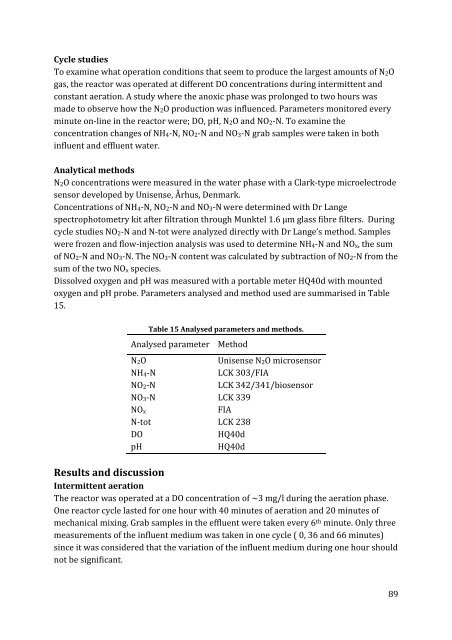N2O production in a single stage nitritation/anammox MBBR process
N2O production in a single stage nitritation/anammox MBBR process
N2O production in a single stage nitritation/anammox MBBR process
Create successful ePaper yourself
Turn your PDF publications into a flip-book with our unique Google optimized e-Paper software.
Cycle studies<br />
To exam<strong>in</strong>e what operation conditions that seem to produce the largest amounts of <strong>N2O</strong><br />
gas, the reactor was operated at different DO concentrations dur<strong>in</strong>g <strong>in</strong>termittent and<br />
constant aeration. A study where the anoxic phase was prolonged to two hours was<br />
made to observe how the <strong>N2O</strong> <strong>production</strong> was <strong>in</strong>fluenced. Parameters monitored every<br />
m<strong>in</strong>ute on-l<strong>in</strong>e <strong>in</strong> the reactor were; DO, pH, <strong>N2O</strong> and NO2-N. To exam<strong>in</strong>e the<br />
concentration changes of NH4-N, NO2-N and NO3-N grab samples were taken <strong>in</strong> both<br />
<strong>in</strong>fluent and effluent water.<br />
Analytical methods<br />
<strong>N2O</strong> concentrations were measured <strong>in</strong> the water phase with a Clark-type microelectrode<br />
sensor developed by Unisense, Århus, Denmark.<br />
Concentrations of NH4-N, NO2-N and NO3-N were determ<strong>in</strong>ed with Dr Lange<br />
spectrophotometry kit after filtration through Munktel 1.6 µm glass fibre filters. Dur<strong>in</strong>g<br />
cycle studies NO2-N and N-tot were analyzed directly with Dr Lange’s method. Samples<br />
were frozen and flow-<strong>in</strong>jection analysis was used to determ<strong>in</strong>e NH4-N and NOx, the sum<br />
of NO2-N and NO3-N. The NO3-N content was calculated by subtraction of NO2-N from the<br />
sum of the two NOx species.<br />
Dissolved oxygen and pH was measured with a portable meter HQ40d with mounted<br />
oxygen and pH probe. Parameters analysed and method used are summarised <strong>in</strong> Table<br />
15.<br />
Table 15 Analysed parameters and methods.<br />
Analysed parameter Method<br />
<strong>N2O</strong><br />
Unisense <strong>N2O</strong> microsensor<br />
NH4-N<br />
LCK 303/FIA<br />
NO2-N<br />
LCK 342/341/biosensor<br />
NO3-N LCK 339<br />
NOx<br />
FIA<br />
N-tot LCK 238<br />
DO<br />
HQ40d<br />
pH<br />
HQ40d<br />
Results and discussion<br />
Intermittent aeration<br />
The reactor was operated at a DO concentration of ~3 mg/l dur<strong>in</strong>g the aeration phase.<br />
One reactor cycle lasted for one hour with 40 m<strong>in</strong>utes of aeration and 20 m<strong>in</strong>utes of<br />
mechanical mix<strong>in</strong>g. Grab samples <strong>in</strong> the effluent were taken every 6 th m<strong>in</strong>ute. Only three<br />
measurements of the <strong>in</strong>fluent medium was taken <strong>in</strong> one cycle ( 0, 36 and 66 m<strong>in</strong>utes)<br />
s<strong>in</strong>ce it was considered that the variation of the <strong>in</strong>fluent medium dur<strong>in</strong>g one hour should<br />
not be significant.<br />
89















